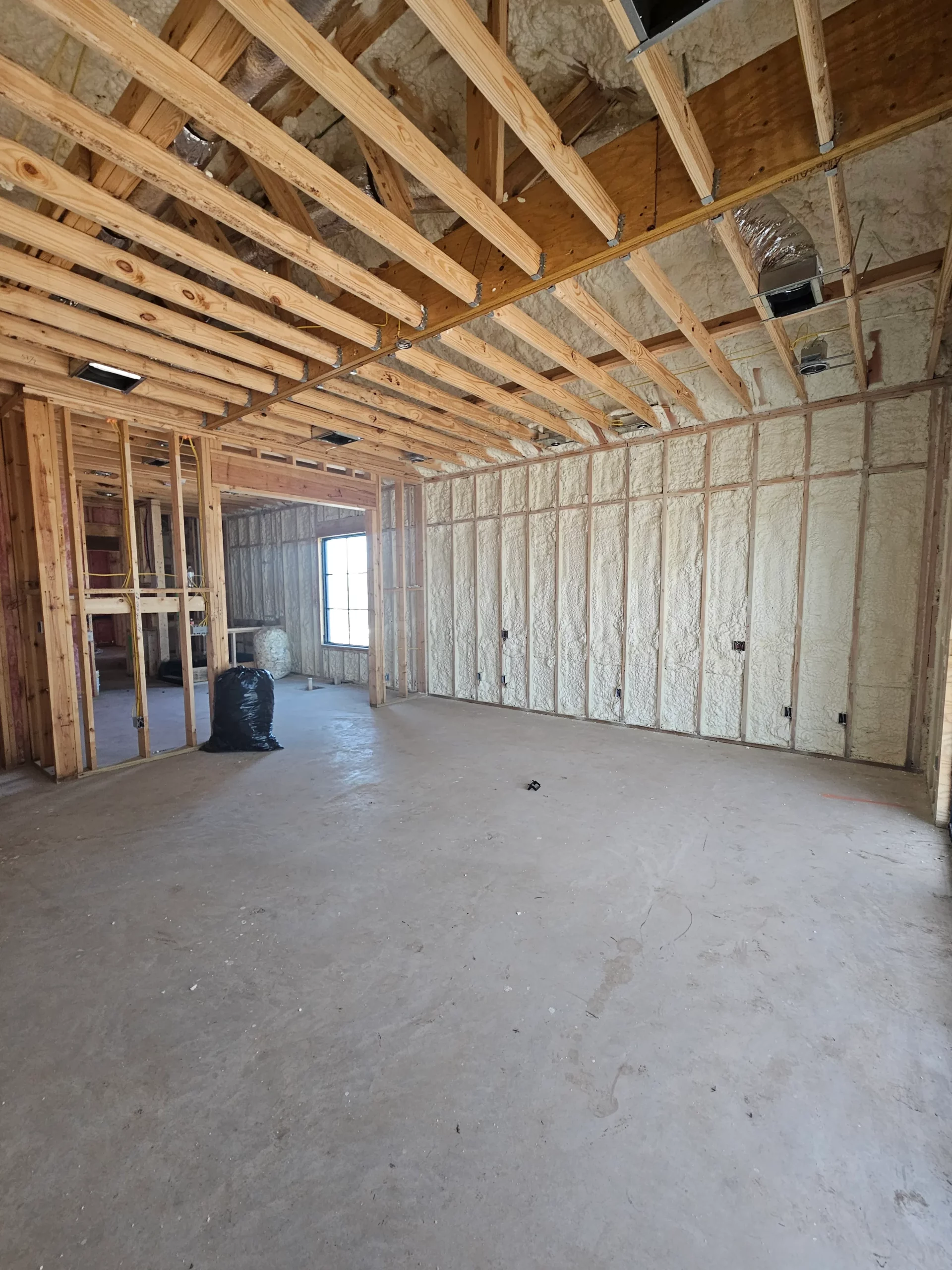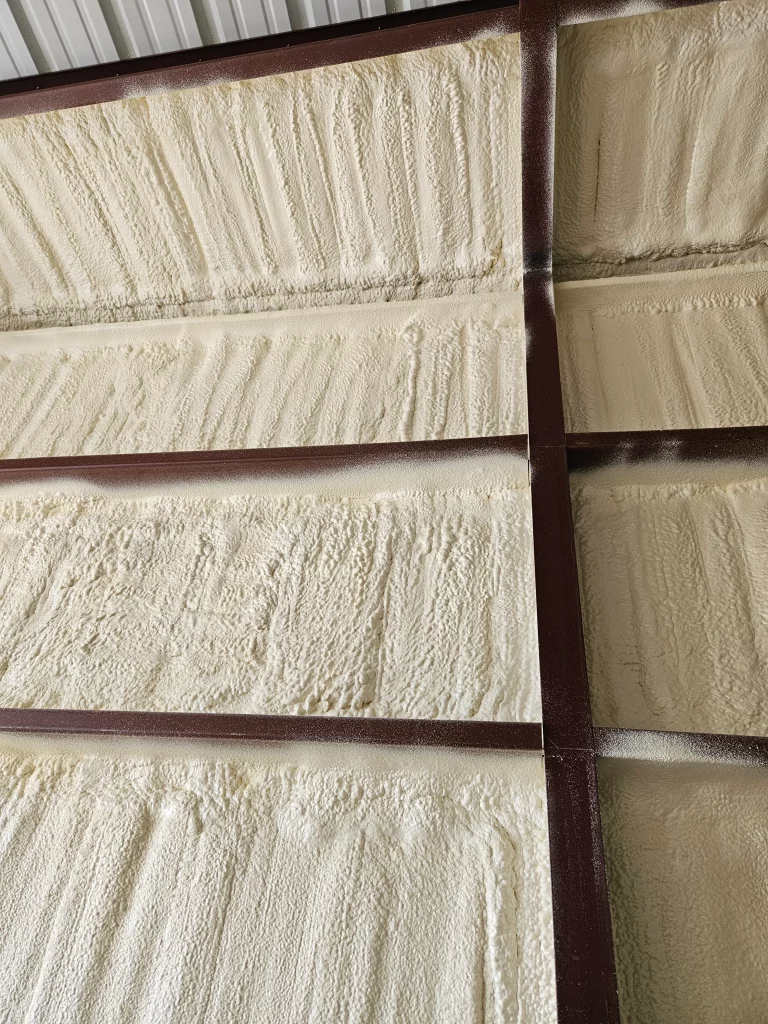
Temple homeowners prevent energy loss with foam by installing spray foam insulation that creates an air-tight thermal barrier, reducing energy costs by 30-50% annually. The most effective approach combines closed-cell spray foam for exterior applications with open-cell foam for interior spaces, specifically addressing Central Texas’s extreme temperature fluctuations and humidity challenges.
Spray foam insulation performs exceptionally well in Temple’s climate because it simultaneously handles air sealing and insulation in one application. Unlike traditional insulation materials that allow air infiltration, foam expands to fill every gap and crack, creating a continuous barrier that prevents conditioned air from escaping and outdoor air from entering. This comprehensive sealing approach addresses the primary cause of energy loss in Texas homes, where HVAC systems typically account for 60-70% of total energy consumption.
Central Texas homes face unique energy challenges due to the region’s climate characteristics. Summer temperatures regularly exceed 95°F for extended periods, while winter conditions can drop below freezing. This temperature variation creates significant thermal stress on building envelopes, leading to air leakage through structural gaps, electrical penetrations, and building material joints.
According to the U.S. Department of Energy, homes lose 25-40% of their conditioned air through uncontrolled air leakage. In Temple specifically, local energy audits conducted by Austin Energy reveal that homes built before 2000 lose an average of 38% of their conditioned air, primarily through attic spaces and wall cavities. Modern spray foam applications reduce this loss to under 10%.
Temple’s geographic location in Bell County presents specific insulation challenges that spray foam addresses effectively. The area experiences high humidity levels during summer months, creating potential moisture problems in wall cavities and attic spaces. Closed-cell spray foam provides moisture control while maintaining thermal performance, preventing the mold and mildew issues common with traditional insulation materials.
Bonus Tip: Install spray foam insulation during Temple’s cooler months (November through February) for optimal curing conditions and improved installer comfort, resulting in better application quality.
| Foam Type | R-Value per Inch | Air Sealing | Moisture Control | Best Application |
|---|---|---|---|---|
| Closed-Cell | 6.0-7.0 | Excellent | Vapor Barrier | Exterior walls, roofing |
| Open-Cell | 3.5-4.0 | Very Good | Breathable | Interior walls, attics |
| Hybrid Application | 4.5-5.5 | Excellent | Selective | Whole-house systems |
Understanding the technical performance characteristics helps homeowners make informed decisions about spray foam applications. The following specifications represent optimal performance standards for Central Texas installations.
| Performance Metric | Closed-Cell Foam | Open-Cell Foam | Traditional Insulation |
|---|---|---|---|
| Thermal Resistance | R-6 to R-7 per inch | R-3.5 to R-4 per inch | R-3.2 to R-3.8 per inch |
| Air Permeability | <0.02 L/(s⋅m²) at 75 Pa | 2-5 L/(s⋅m²) at 75 Pa | 15-25 L/(s⋅m²) at 75 Pa |
| Moisture Permeability | <1.0 perm | 8-16 perms | Variable |
| Adhesion Strength | >25 psi | >15 psi | Not applicable |
| Fire Rating | Class 1 with barrier | Class 1 with barrier | Varies by material |
These specifications demonstrate why spray foam outperforms traditional insulation in Temple’s demanding climate. The superior air sealing properties directly translate to energy savings, while moisture control prevents long-term structural issues common in humid climates.
Effective energy loss prevention requires strategic foam placement that addresses the specific thermal bridging and air leakage patterns common in Temple homes. Professional installation focuses on creating continuous thermal boundaries that eliminate temperature transfer paths.
Attic applications receive priority because rising hot air creates the strongest pressure differentials during summer months. Spray foam applied to the underside of roof decking creates conditioned attic space, reducing HVAC ductwork temperature exposure and improving overall system efficiency.
Wall cavity applications target thermal bridging through wooden framing members. In Temple’s construction patterns, thermal bridging can account for 15-20% of total heat transfer. Spray foam minimizes this effect by enveloping framing members and creating uniform thermal resistance.
Bonus Tip: Schedule foam installation immediately after electrical and plumbing rough-in work to ensure complete sealing around all penetrations, maximizing energy efficiency performance.
Several factors influence spray foam installation success and long-term performance in Temple homes. Timing considerations include avoiding installation during extreme temperature periods when ambient conditions exceed manufacturer specifications. Spring and fall installation windows provide optimal conditions for proper foam curing and expansion.
Building age affects installation complexity and material selection. Homes built before 1980 may require additional preparation work to address settling and structural gaps. Modern construction typically accommodates spray foam installation with minimal preparation requirements.
Existing insulation removal requirements vary based on current material condition and type. Wet or damaged insulation must be completely removed before foam application. Dry, undamaged insulation may remain in place for certain applications, reducing project costs.
Budget allocation should account for both material and labor costs, which vary seasonally based on demand. Professional installation ensures proper application depth and coverage, maximizing energy performance and warranty protection.
According to the Texas State Energy Conservation Office, properly installed spray foam insulation typically pays for itself through energy savings within 5-7 years in Central Texas homes. This payback period shortens to 3-4 years for homes with significant existing air leakage issues.

Spray Foam Tech delivers comprehensive insulation solutions designed specifically for Temple homeowners seeking maximum energy efficiency. These services address the complete thermal envelope requirements for Central Texas homes.
Spray foam insulation delivers maximum energy savings when combined with complementary efficiency measures. Air sealing benefits multiply when paired with efficient HVAC systems, programmable thermostats, and high-performance windows. This integrated approach can reduce total energy consumption by 50-70% compared to code-minimum construction.
Regular maintenance requirements for spray foam are minimal but important for sustained performance. Annual inspections should check for any signs of damage or separation, particularly around areas with building movement or settling. Professional assessment every 5-10 years ensures continued optimal performance.
Temple homeowners achieve the greatest energy loss prevention by addressing the complete building envelope systematically. Spray foam provides the foundation for energy efficiency, creating the air-tight thermal barrier necessary for all other efficiency measures to perform optimally.
Temple homeowners ready to eliminate energy loss through professional spray foam installation can access expert guidance and custom solutions. Spray Foam Tech provides comprehensive assessments that identify specific energy loss patterns and recommend targeted solutions for maximum efficiency gains.
Professional installation ensures proper application techniques, optimal material selection, and warranty protection for long-term performance. Each project receives customized attention based on home construction, existing conditions, and efficiency goals.
Contact Spray Foam Tech at (737) 777-9590 or oldworldtx@hotmail.com for detailed energy assessments and installation scheduling. Expert consultation helps homeowners make informed decisions about insulation investments that deliver lasting energy savings and improved comfort.
Most residential installations complete within 1-2 days depending on home size and complexity. Single-story homes under 2,000 square feet typically require one day, while larger or multi-story homes may require additional time for complete coverage.
Remove personal belongings from work areas and ensure electrical and plumbing rough-in work is complete. Cover or remove sensitive items that could be affected by overspray, and provide clear access to all application areas.
Properly installed spray foam maintains its thermal properties and structural integrity in temperatures exceeding 150°F. The material’s thermal resistance actually improves in hot weather, providing maximum cooling cost benefits when needed most.
Bonus Tip: Plan spray foam installation to coincide with HVAC system maintenance or replacement for maximum efficiency gains and potential utility rebate opportunities available through local energy programs.
Closed-cell spray foam applications may require modified ventilation strategies since the material creates vapor barriers. Mechanical ventilation systems ensure proper indoor air quality while maintaining energy efficiency benefits. Open-cell applications typically maintain natural breathability.
Quality spray foam installations maintain thermal performance for 20-30 years without degradation. The material does not settle, compress, or lose R-value over time like traditional insulation materials. Proper installation and building maintenance extend performance life indefinitely.
Spray foam typically reduces HVAC system workload by 20-40%, potentially allowing for smaller replacement systems when upgrades become necessary. Existing systems benefit from reduced runtime and improved efficiency without modification requirements.
Professional installations typically include material warranties of 10-25 years and workmanship warranties of 1-5 years. Warranty terms vary by manufacturer and installer, with longer coverage available for closed-cell applications.
Initial spray foam costs range from 2-4 times traditional insulation costs, but energy savings and performance benefits provide positive return on investment within 5-7 years. Long-term value includes reduced HVAC maintenance, improved comfort, and enhanced resale value.